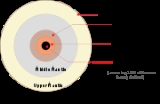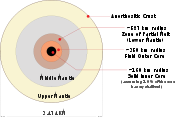
Hollow moon
Encyclopedia

Pseudoscience
Pseudoscience is a claim, belief, or practice which is presented as scientific, but which does not adhere to a valid scientific method, lacks supporting evidence or plausibility, cannot be reliably tested, or otherwise lacks scientific status...
hypothesis proposing that Earth
Earth
Earth is the third planet from the Sun, and the densest and fifth-largest of the eight planets in the Solar System. It is also the largest of the Solar System's four terrestrial planets...
's Moon
Moon
The Moon is Earth's only known natural satellite,There are a number of near-Earth asteroids including 3753 Cruithne that are co-orbital with Earth: their orbits bring them close to Earth for periods of time but then alter in the long term . These are quasi-satellites and not true moons. For more...
is either wholly hollow or otherwise contains a substantial interior space. No scientific evidence exists to support the idea.
The concept is related to or derived from the better-known Hollow Earth
Hollow Earth
The Hollow Earth hypothesis proposes that the planet Earth is either entirely hollow or otherwise contains a substantial interior space. The hypothesis has been shown to be wrong by observational evidence, as well as by the modern understanding of planet formation; the scientific community has...
theory, and was an infrequent but recurring plot device in pre-spaceflight
Spaceflight
Spaceflight is the act of travelling into or through outer space. Spaceflight can occur with spacecraft which may, or may not, have humans on board. Examples of human spaceflight include the Russian Soyuz program, the U.S. Space shuttle program, as well as the ongoing International Space Station...
science fiction
Science fiction
Science fiction is a genre of fiction dealing with imaginary but more or less plausible content such as future settings, futuristic science and technology, space travel, aliens, and paranormal abilities...
.
Two versions
The Hollow Moon theory never gained enough popularity for any major quasi-scientific hypothesis attempting to rationalize it to become notable. Modern Hollow Moon adherents can however be broadly grouped in two major camps:- the Moon's formation process produced a hollow sphere through natural means. Details vary widely; the proposed mechanism is usually an undefined or pseudoscentific factor in accretion-disk dynamics. Some proponents of this view maintain that the Moon is not exceptional, but that all planetary bodies are hollow.
- the Moon's hollowness stems from its being an artifactArtifact (archaeology)An artifact or artefact is "something made or given shape by man, such as a tool or a work of art, esp an object of archaeological interest"...
. This view (the "Spaceship Moon TheorySpaceship Moon TheoryThe Spaceship Moon Theory, also known as the Vasin-Shcherbakov Theory, is a pseudoscientific theory that claims the Earth's moon may actually be an alien spacecraft...
") usually correlates with other beliefs such as UFOs or ancient astronautsAncient astronautsSome writers have proposed that intelligent extraterrestrial beings have visited Earth in antiquity or prehistory and made contact with humans. Such visitors are called ancient astronauts or ancient aliens. Proponents suggest that this contact influenced the development of human cultures,...
.
The scientific community considers both sub-theories to be entirely unsupported by evidence.
Scientific perspective
Mainstream scientific opinion on the internal structure of the MoonInternal structure of the Moon
Having a mean density of 3,346.4 kg/m³, the Moon is a differentiated body, being composed of a geochemically distinct crust, mantle, and core. This structure is believed to have resulted from the fractional crystallization of a magma ocean shortly after its formation about 4.5 billion years ago...
overwhelmingly supports a solid internal structure with a thin crust, an extensive mantle and a small denser core. This is based on:
- Seismic observations. Besides Earth, the Moon is the only planetary body with a seismic observation network in place. Analysis of lunar seismic data have helped constrain the thickness of the crust (~45 km) and mantle, as well as the core radius (~350 km).
- Moment of inertia parameters. For the Moon, moment of inertia parameters have demonstrated that the core is ~1.4% of the total mass. One such parameter, the normalized polar moment of inertia, is 0.393+/-0.001. This is very close to the value for a solid object with radially constant density, which would be 0.4 (for comparison, Earth's value is 0.33). The normalized polar moment of inertia for a hollow Moon would have a higher value, closer to 0.67. In other words, the moment of inertia parameters indicate that the core of the Moon is both dense and small, with the rest of the Moon consisting of material with nearly-constant density.
- Fine-scale variation (e.g., variation along the orbit of the Lunar Prospector orbiterLunar ProspectorThe Lunar Prospector mission was the third selected by NASA for full development and construction as part of the Discovery Program. At a cost of $62.8 million, the 19-month mission was designed for a low polar orbit investigation of the Moon, including mapping of surface composition and possible...
) of the lunar gravitational field, which is consistent with geologic processes involving a crust, mantle, and core.
The large-scale gravitational field of the Moon, however, is unaffected by the internal distribution of mass if the internal density is assumed to vary only radially. For example, had the Moon been replaced with a point object of identical mass, the current gravitational field would continue to exist at distances greater than the ~1700 km lunar radius. This can be derived directly for a spherically symmetric Moon by applying the integral form of Gauss's law. Therefore, the large-scale gravitational field of the Moon does not convey any information about the internal radial distribution of mass. Hollow Moon proponents would, however, have to account for the incredible density of the Moon's crust if it were in fact hollow. As gravitational pull is determined by mass, a hollow moon would require an inordinately dense crust to achieve observed gravitational values.
In literature
- In H.G. Wells's book The First Men in The MoonThe First Men in the MoonThe First Men in the Moon is a 1901 scientific romance novel by the English author H. G. Wells. The novel tells the story of a journey to the moon undertaken by the two protagonists, the impoverished businessman Mr Bedford and the brilliant but eccentric scientist Dr. Cavor...
(1901), Wells describes the insect-like "Selenites" who live inside a hollow Moon. - Edgar Rice BurroughsEdgar Rice BurroughsEdgar Rice Burroughs was an American author, best known for his creation of the jungle hero Tarzan and the heroic Mars adventurer John Carter, although he produced works in many genres.-Biography:...
wrote an adventure novel, The Moon MaidThe Moon MaidThe Moon Maid is an Edgar Rice Burroughs Lost World novel. It was written in three parts, Part 1 was begun in June 1922 under the title The Moon Maid, Part 2 was begun in 1919 under the title Under the Red Flag, later retitled The Moon Men, Part 3 was titled the The Red Hawk...
(1922), set in the interior of a postulated hollow Moon which had an atmosphere and was inhabited. In the sequel, The Moon Men, natives of the hollow Moon invade and conquer Earth. Burroughs also wrote the PellucidarPellucidarPellucidar is a fictional Hollow Earth milieu invented by Tarzan creator Edgar Rice Burroughs for a series of action adventure stories. In a notable crossover event between Burroughs' series, there is a Tarzan story in which the Ape Man travels into Pellucidar.The stories initially involve the...
series, set in the interior of a hollow EarthHollow EarthThe Hollow Earth hypothesis proposes that the planet Earth is either entirely hollow or otherwise contains a substantial interior space. The hypothesis has been shown to be wrong by observational evidence, as well as by the modern understanding of planet formation; the scientific community has...
. - That Hideous StrengthThat Hideous StrengthThat Hideous Strength is a 1945 novel by C. S. Lewis, the final book in Lewis's theological science fiction Space Trilogy. The events of this novel follow those of Out of the Silent Planet and Perelandra and once again feature the philologist Elwin Ransom...
(1945) by C.S. Lewis takes place on Earth, but a hollow Moon is an important part of the novel's background, and is known by its inhabitants as "Sulva." - The Lomokome Papers, Herman WoukHerman WoukHerman Wouk is a Pulitzer Prize-winning American author of novels including The Caine Mutiny, The Winds of War, and War and Remembrance.-Biography:...
's little-known venture into science fiction (1947), also uses the concept. - NeznaikaNeznaikaDunno, or Know-Nothing is an anti-hero created by the Soviet children's writer Nikolay Nosov.Dunno, recognized by his bright blue hat, canary-yellow trousers, orange shirt, and green tie, is the title character of Nosov's world-famous trilogy, The Adventures of Dunno and his Friends , Dunno in Sun...
on the Moon, (1965), by Russian author Nikolay NosovNikolay NosovNikolai Nikolaevich Nosov was a Soviet children's literature writer, the author of a number of humorous short stories, a school novel, and the popular trilogy of fairy tale novels about the adventures of Neznaika and his friends.-Early life:...
.

